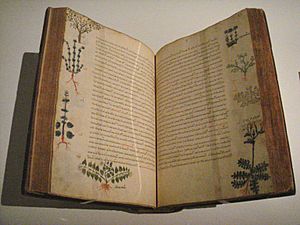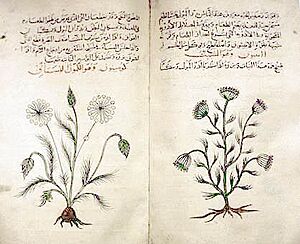History of pharmacy facts for kids
The history of pharmacy is all about how people have learned to make and use medicines over thousands of years. For a long time, making medicines was part of being a doctor. But in the 1800s, pharmacy became its own special science. Before pharmacists, there were "apothecaries" who worked with priests and doctors to help sick people.
Contents
Early Medicine
Even before written history, people used plants for medicine. Scientists have found signs of medicinal herbs in ancient caves, showing that early humans knew about healing plants. They probably learned by watching animals and trying different things, like using cool water, leaves, or mud to soothe pain.
Ancient Times
In ancient lands like Mesopotamia (where Iraq is today) and Egypt, people wrote down their medical knowledge.
- Mesopotamia: People wrote prescriptions on clay tablets. These texts included instructions for making medicines, like grinding herbs, boiling them, and filtering liquids. Babylon had some of the first known pharmacies, where pharmacists worked with doctors and priests.
- Egypt: Ancient Egyptians wrote down their knowledge in special scrolls called papyri, like the Ebers Papyrus from around 1550 BC.
Greece
In ancient Greece, doctors and herbalists had different jobs. Herbalists gathered plants for doctors to turn into medicines. A very important Greek doctor named Pedanius Dioscorides wrote a five-book guide called De materia medica around 60-78 AD. It described over 600 plants and their uses. This book was used for hundreds of years and was very important for medicine.
Asia
- China: The oldest Chinese book on medicines is the Shennong Ben Cao Jing, written around the first century AD. It lists many herbs and their uses.
- India: In India, traditional medicine (called Ayurveda) also has old texts describing medicinal substances, dating back to the third or fourth century AD.
- Japan: In early Japan (around 538–794 AD), people who acted like modern pharmacists were highly respected. They even had a higher rank than doctors in the Emperor's court!
Middle Ages
Middle East
The first pharmacies, or drug stores, were set up in Baghdad in 754 AD, during a time known as the Islamic Golden Age. By the 800s, these pharmacies were regulated by the government.
Scientists in the Middle East made great progress in botany (the study of plants) and chemistry, which helped medicine grow.
- Muhammad ibn Zakarīya Rāzi (865–915) encouraged using chemical compounds in medicine.
- Abu al-Qasim al-Zahrawi (936–1013) found new ways to prepare medicines, like using sublimation and distillation. His book, Liber servitoris, gave recipes and explained how to prepare simple ingredients for complex drugs.
- Al-Biruni (973–1050) wrote an important book called Kitab al-Saydalah (The Book of Drugs). It described what drugs do and explained the job of a pharmacist.
- Ibn Sina (Avicenna) described over 700 preparations in his famous book, The Canon of Medicine.
Later, around the 1200s and 1300s, pharmacists in the Middle East started focusing more on practical ways to use medicines. For example, a pharmacist named Abu ‘I-Munā al-Kuhín al-‘Attār wrote a 25-chapter guide called Minhāj al-dukkān (How to run a pharmacy). It explained drug titles, ingredients, how to prepare them, and dosages. This showed a growing interest in sharing pharmacy knowledge with everyone.
Europe
After the fall of the Western Roman Empire in the 400s, medical knowledge in Europe faced challenges. However, a medical school in Salerno, Italy, became famous by the 1000s.
In the early 1000s, a scholar named Constantine the African translated many Arabic medical books into Latin. This helped spread new ideas about medicine in Europe.
- Separation of Roles: In Europe, pharmacy-like shops appeared in the 1100s. In 1240, Emperor Frederic II made a rule that doctors and apothecaries (pharmacists) had to be separate professions. This was a big step!
- Old Pharmacies: Some very old pharmacies are still open today! The Franciscan Monastery in Dubrovnik, Croatia, has a pharmacy that opened in 1317. The Town Hall Pharmacy in Tallinn, Estonia, has been running since at least 1422 in its original building.
- First Pharmacopeia: Florence, Italy, was home to the first official "pharmacopeia" called the Nuovo Receptario. This was a book that all pharmacies had to use as a guide for making medicines.
- Health Policies: The Republic of Venice was one of the first places to have modern health rules, requiring that the ingredients of drugs be public knowledge.
Modern Pharmacy
Industrial Age
The 1800s brought many new inventions and discoveries. German scientists learned how to purify individual chemical compounds from natural sources.
- New Medicines: Chloral hydrate was introduced as a sleeping aid in 1869. Chloroform was first used as an anesthetic (to make people unconscious for surgery) in 1847.
- Mental Health: In 1950, a drug called Chlorpromazine was discovered. It was a big step forward in treating mental health conditions.
- Professional Organizations: In the United States, the American Pharmaceutical Association was formed in 1852. Its goal was to improve the role of pharmacists in patient care and share information.
- Insulin: In 1921, Frederick Banting and Charles Best discovered insulin, a hormone that lowers blood sugar. This discovery changed the lives of people with diabetes.
- Penicillin: Alexander Fleming discovered the first antibiotic, penicillin, after noticing a fungus that could kill bacteria. This was a huge breakthrough in fighting infections.
Pharmacy in Singapore
In Singapore, the first organized medical supply system was set up during Raffles' expedition. When the British settled in Singapore, they built hospitals for soldiers, sailors, and civilians.
- Early Pharmacists: The people who prepared medicines were called Apothecaries. They were like medical assistants. To help with staff shortages, local students were trained for five years to become assistant apothecaries.
- Private Pharmacies: Many apothecaries later left to open their own private pharmacies, which advertised in newspapers. These were some of the first pharmacy businesses.
- Western Medicine: Besides traditional Chinese medicine, Western medicine also became popular. A German doctor opened a dispensary called the German Medicine Deity Medical Office.
- Formal Training: Throughout the 1900s, Singapore created laws for pharmacy education and licensing. In 1933, a law made training and registration for pharmacists a formal requirement. The King Edward VII College of Medicine started admitting pharmacy students in 1935.
See also
 In Spanish: Historia de la farmacia para niños
In Spanish: Historia de la farmacia para niños
- International Society for the History of Pharmacy
- British Society for the History of Pharmacy
- History of medicine
- History of pharmacy automation
- History of pharmacy in the United States
- List of drugs by year of discovery
- Museum of the History of Lithuanian Medicine and Pharmacy






